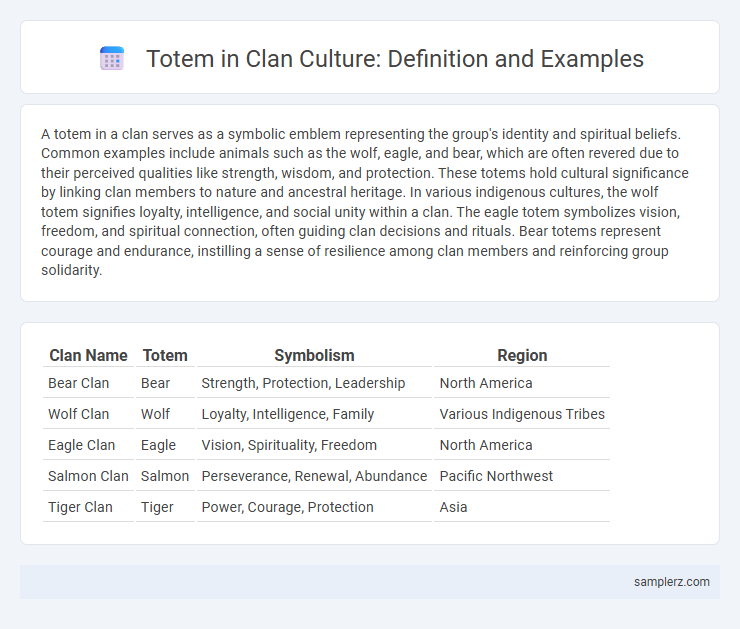A totem in a clan serves as a symbolic emblem representing the group's identity and spiritual beliefs. Common examples include animals such as the wolf, eagle, and bear, which are often revered due to their perceived qualities like strength, wisdom, and protection. These totems hold cultural significance by linking clan members to nature and ancestral heritage. In various indigenous cultures, the wolf totem signifies loyalty, intelligence, and social unity within a clan. The eagle totem symbolizes vision, freedom, and spiritual connection, often guiding clan decisions and rituals. Bear totems represent courage and endurance, instilling a sense of resilience among clan members and reinforcing group solidarity.
Table of Comparison
| Clan Name | Totem | Symbolism | Region |
|---|---|---|---|
| Bear Clan | Bear | Strength, Protection, Leadership | North America |
| Wolf Clan | Wolf | Loyalty, Intelligence, Family | Various Indigenous Tribes |
| Eagle Clan | Eagle | Vision, Spirituality, Freedom | North America |
| Salmon Clan | Salmon | Perseverance, Renewal, Abundance | Pacific Northwest |
| Tiger Clan | Tiger | Power, Courage, Protection | Asia |
Introduction to Clan Totems: Meaning and Significance
Clan totems represent symbolic emblems, often animals or natural elements, embodying the identity and spiritual connection of a specific clan within indigenous cultures. These totems serve as a guiding force, reflecting ancestral lineage, values, and protection principles rooted in tradition. The significance of clan totems extends beyond symbolism, influencing social structure, rituals, and the preservation of cultural heritage across generations.
Historical Origins of Totemism in Clans
Totemism in clans originated in prehistoric societies as a spiritual system linking a group to a specific animal, plant, or natural object, serving as a symbolic ancestor and protector. Anthropological studies trace its roots to Indigenous Australian and Native American cultures, where totems reinforced social cohesion and guided clan responsibilities. These historical origins highlight totems as essential elements in clan identity, rituals, and governance throughout ancient human history.
Common Animal Totems and Their Symbolism
Common animal totems in clans include the wolf, symbolizing loyalty and intelligence; the eagle, representing vision and freedom; and the bear, denoting strength and protection. These totems serve as spiritual guides and embody core clan values, influencing rituals and social structures. Understanding the symbolism of these animal totems reveals the cultural identity and ancestral connections within the clan system.
Plant-Based Totems: Nature’s Influence on Clan Identity
Plant-based totems, such as the oak tree in Celtic clans or the sacred fig in Indian tribes, symbolize strength, wisdom, and spiritual growth, deeply influencing clan identity and cohesion. These botanical emblems serve as ancestral anchors, representing the clan's connection to nature and their environment. The use of plant totems reinforces cultural values and traditions that promote harmony with the natural world.
Spiritual and Mythical Totems in Clan Traditions
Spiritual and mythical totems in clan traditions serve as symbolic representations of ancestral spirits and protective forces that guide the community's identity and values. These totems often embody animals, natural elements, or legendary creatures believed to possess sacred powers, fostering a deep connection between the clan and the spiritual realm. Rituals and storytelling surrounding these totems reinforce social cohesion and transmit cultural knowledge across generations.
Regional Variations: Totems in Different Cultures
Totems vary significantly across cultures, reflecting diverse environmental and spiritual contexts. In Indigenous Australian clans, the kangaroo or emu often serves as a totem, symbolizing ancestral connections and clan identity. Meanwhile, among the Haida people of the Pacific Northwest, animal totems like the raven or eagle represent lineage and convey social status within the community.
Rituals and Ceremonies Involving Clan Totems
Clan totems play a central role in rituals and ceremonies, symbolizing spiritual connection and ancestral heritage within indigenous cultures. Specific rites, such as initiation ceremonies and seasonal festivals, often incorporate totemic symbols through dance, song, and visual art to invoke protection and guidance from the clan's spiritual ancestors. These practices reinforce social bonds and cultural identity, ensuring the transmission of clan traditions across generations.
Totems as Markers of Social Structure and Roles
Totems function as symbolic markers that delineate social structures and roles within clans, embodying kinship ties and group identity. These emblematic figures or animals designate lineage, guiding clan members' responsibilities, rights, and spiritual obligations. By embodying collective heritage, totems reinforce social cohesion and cultural continuity through generations.
Contemporary Interpretations of Clan Totems
Contemporary interpretations of clan totems often blend traditional symbolism with modern identity, serving as powerful emblems of cultural heritage and community values. For example, Indigenous groups may adopt animal totems such as the wolf or eagle, integrating them into digital art and social media to foster connection among younger generations. These modern adaptations sustain ancestral narratives while promoting environmental awareness and social cohesion within the clan.
The Legacy and Preservation of Totemic Clans
Totemic clans embody a rich cultural legacy by preserving ancestral symbols that represent their identity and spiritual connection to nature. These totems, often animals or natural elements, serve as enduring emblems passed down through generations, reinforcing social cohesion and guiding clan rituals. Preservation of these totems ensures the survival of clan histories, oral traditions, and collective memory, safeguarding their unique cultural heritage in modern society.

example of totem in clan Infographic
 samplerz.com
samplerz.com